

How Perfectionism Can Lead to Procrastination (and What to Do About It) 15 Time Boxing Strategies to Get Things Done. Putting it simply, time boxing is the most effective time management tool that I know of.

Even if you already know and use it to some extent, there is a good chance that you can make it even better with some of the tips that follow. For those new to it, time boxing is simply fixing a time period to work on a task or group of tasks. Instead of working on a task until it’s done, you commit to work on it for a specific amount of time instead. But don’t let the simplicity of the concept deceive you — there’s much more to this tool than meets the eye. Many people already wrote about it (check Dave Cheong for a great start, as well as J.D Meier and Steve Pavlina). 1. The most obvious use of a time box is to make progress on big tasks. 2. Week 12: How Do You Prioritize – By Quantity or Quality. This week I came across a quote by renowned productivity expert David Allen: “Maximum productivity is making something happen with as little effort as possible.”

This was a surprise to me. I was under the impression that maximum productivity is cramming as many things as possible onto my to-do list and then rushing around like a maniac trying to get them all done. Okay, I’m exaggerating a little. But this quote made me realize something important: I define “productivity” in terms of the number of things I’ve done. I’m measuring my daily performance by the number of tasks accomplished. Week 9: Saved by the Timer. Over the last eight weeks, I’ve focused on making small changes to increase my physical vitality.
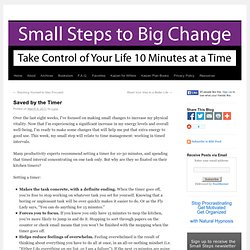
Now that I’m experiencing a significant increase in my energy levels and overall well-being, I’m ready to make some changes that will help me put that extra energy to good use. This week, my small step will relate to time management: working in timed intervals. Many productivity experts recommend setting a timer for 10-30 minutes, and spending that timed interval concentrating on one task only. But why are they so fixated on their kitchen timers? Week 39: How Do You Treat Your Future Self. I’d like to start with a simple exercise this week: take a few seconds to close your eyes and imagine yourself at this time next year.
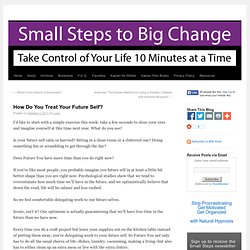
What do you see? Is your future self calm or harried? Be More with Less. How to Declutter. Declutter 15 Minutes per Day. Tips for Not Getting Sidetracked. Your personal online coach to help you gain control of your house and home. The Minimalist Principle: Omit Needless Things. “Omit needless words.” - William Strunk Jr., The Elements of Style While minimalist aesthetics and products and the minimalist lifestyle appeals to a lot of people, they find it easier to like it than to live it.
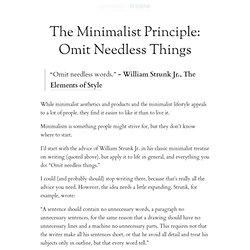
Minimalism is something people might strive for, but they don’t know where to start. I’d start with the advice of William Strunk Jr. in his classic minimalist treatise on writing (quoted above), but apply it to life in general, and everything you do: “Omit needless things.” I could (and probably should) stop writing there, because that’s really all the advice you need. However, the idea needs a little expanding. “A sentence should contain no unnecessary words, a paragraph no unnecessary sentences, for the same reason that a drawing should have no unnecessary lines and a machine no unnecessary parts.
» A Guide to Creating a Minimalist Home. Post written by Leo Babauta.
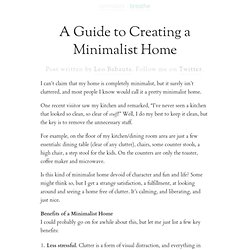
Follow me on Twitter. I can’t claim that my home is completely minimalist, but it surely isn’t cluttered, and most people I know would call it a pretty minimalist home. One recent visitor saw my kitchen and remarked, “I’ve never seen a kitchen that looked so clean, so clear of stuff!” Well, I do my best to keep it clean, but the key is to remove the unnecessary stuff. For example, on the floor of my kitchen/dining room area are just a few essentials: dining table (clear of any clutter), chairs, some counter stools, a high chair, a step stool for the kids. Is this kind of minimalist home devoid of character and fun and life? » Simple Living Manifesto: 72 Ideas to Simplify Your Life. “Simplicity is the peak of civilization.” – Jessie Sampter By Leo Babauta A simple life has a different meaning and a different value for every person.
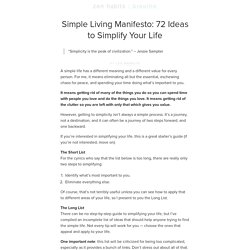
For me, it means eliminating all but the essential, eschewing chaos for peace, and spending your time doing what’s important to you. It means getting rid of many of the things you do so you can spend time with people you love and do the things you love. It means getting rid of the clutter so you are left with only that which gives you value. » Edit Your Life, Part 2: Your Rooms. By Leo Babauta I’m a former newspaper editor, and one of the things I learned was to edit brutally (no sarcastic comments about why I don’t do that with my blog posts).
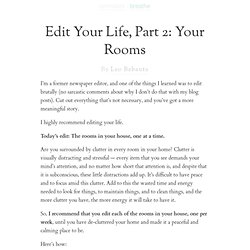
Cut out everything that’s not necessary, and you’ve got a more meaningful story. I highly recommend editing your life. Today’s edit: The rooms in your house, one at a time. Are you surrounded by clutter in every room in your home? So, I recommend that you edit each of the rooms in your house, one per week, until you have de-cluttered your home and made it a peaceful and calming place to be.
Here’s how: First, choose a room to do this week. OK, your room should look pretty good now. Now, this editing process is not a destination, but an ongoing process. Surprising Cleaning New Uses. Speed-clean your house. Clutter Control Checklist. Home - Expert Advice - The Organizer's Toolbox - Tip Sheets Tips And Tricks - Clutter Feel free to use this tip sheet / checklist as you tackle your own ""do-it-yourself"" organizing projects.
If you would like to or this information, please click here for reprinting instructions.